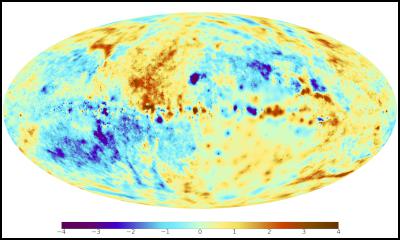Victoria researchers help develop map of Milky Way

Click for full size version
A sky map of the Faraday effect caused by the magnetic fields of the Milky Way. Red and blue colours indicate regions of the sky where the magnetic field points toward and away from the observer, respectively. Image: Max Planck Institute for Astrophysics.
MEDIA RELEASE
21 February 2012
Victoria researchers help develop map of Milky Way
We now have a new way of viewing the Milky Way, thanks to Victoria astronomer Melanie Johnston-Hollitt and one of her undergraduate students.
Dr Johnston-Hollitt and student Luke Pratley, who is about to begin an Honours degree in Physics, are part of an international team that has produced the highest precision map ever of the Milky Way galaxy’s magnetic field.
The team, led by Niels Oppermann of Germany’s Max Planck Institute for Astrophysics (MPA), pooled data from radio astronomy observations to map the galaxy’s magnetic field.
In 2004, Dr Johnston-Hollitt produced the first such map of the Milky Way with Dr Christopher Hollitt from the School of Engineering and Computer Science at Victoria University.
“Back then there were only 800 data points to use; now we have 41,000 so we are able to map for the first time the magnetic field of the Milky Way in detail like we've not seen before,” says Dr Johnston-Hollitt.
The Senior Lecturer in Victoria’s School of Chemical and Physical Sciences says there has been a renaissance in radio astronomy in recent years.
“The map shows the rapid advance of radio telescopes that work in a different way to optical telescopes.
“You can’t directly ‘see’ other galaxies by looking through a radio telescope but we can use computers to translate radio waves into images. There are parts of space where a radio telescope will allow us to ‘see’ further than optical telescopes.”
In making the new map, the research team measured the light from background galaxies and how the light changes as it passes through the Milky Way to produce a 3D view of the galaxy.
In particular, the researchers were able to use the light that is affected by the galaxy’s magnetic fields—polarised light—to map the galaxy’s structure. This technique is known as the Faraday Rotation.
“The Milky Way is hard to map because we are sitting on the edge of the galaxy looking through it However, we know that spiral galaxies like the Milky Way have magnetic fields that follow a particular pattern so we were able use polarised light to map the magnetic fields.”
Dr Johnston-Hollitt says that having many data sources helped create such an accurate map.
The new, high-precision map not only shows the structure of the galaxy’s magnetic field on a large scale, it also reveals small-scale features that help scientists better understand other aspects such as turbulence in galactic gas.
ENDS


 Hugh Grant: Lessons From Australia - How Digital Tools Could Support NZ Nurses In Palliative Care
Hugh Grant: Lessons From Australia - How Digital Tools Could Support NZ Nurses In Palliative Care Canterbury Museum: Dinosaur Dolphins Survived In New Zealand Long After Extinction Elsewhere
Canterbury Museum: Dinosaur Dolphins Survived In New Zealand Long After Extinction Elsewhere Retail NZ: Retailers Still Under Pressure At End Of 2024
Retail NZ: Retailers Still Under Pressure At End Of 2024  University of Canterbury: Research Sheds Light On Fire Risk For Canterbury
University of Canterbury: Research Sheds Light On Fire Risk For Canterbury GE Free NZ: Potential $20 Billion Loss In Export Demand Threatens Rural Communities
GE Free NZ: Potential $20 Billion Loss In Export Demand Threatens Rural Communities Science Media Centre: Carbon-storing Construction Materials – Expert Reaction
Science Media Centre: Carbon-storing Construction Materials – Expert Reaction



